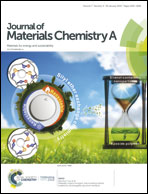Low boiling point solvent additives enable vacuum drying-free processed 230 nm thick PTB7-Th:PC71BM active layers with more than 10% power conversion efficiency†
Abstract
In this work, three fast removable solvent additives o-chloroanisole (CBE), o-chlorobenzaldehyde (CBA), and o-chloroacetophenone (CBK) with low boiling points (bp.) of 195, 212, and 230 °C, respectively, were applied for morphology control of PTB7-Th:PC71BM active layers. Without a vacuum drying process, CBE, CBA, and CBK could work well as fast removable solvent additives in chlorobenzene (CB) host solvent. Relative to the routine 1 : 1.5, a D/A ratio of 1 : 2 is more beneficial for device performances with thicker active layers because of increased charge extraction rates and longer carrier lifetimes. At a thickness of ∼100 nm, CBE, CBA, and CBK gave PCEs between 9.51% and 9.55% while for 230 nm thick active layers, CBE, CBA, and CBK afforded PCEs of 10.12%, 9.90%, and 9.27%, respectively, well demonstrating the advantage of low bp. solvent additives in vacuum drying-free processing of thick active layers. Relative to the ∼100 nm level, an optimal PCE at the ∼200 nm level is more useful for defining a larger processing window that can help fabrication of pin-hole free active layers during high speed printing. Therefore, the fast removable solvent additive strategy has big potential to upgrade some high efficiency active layer materials to a more roll-to-roll compatible level.



 Please wait while we load your content...
Please wait while we load your content...